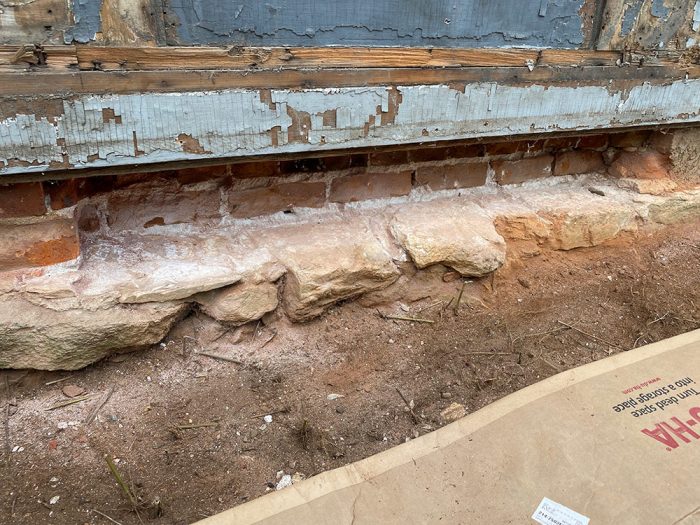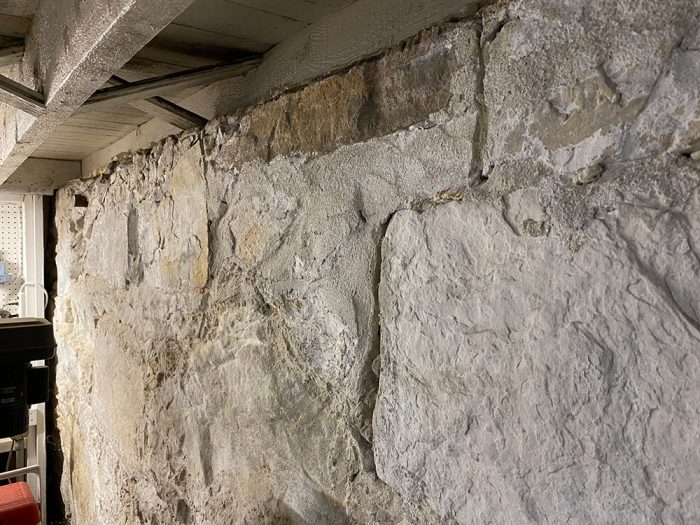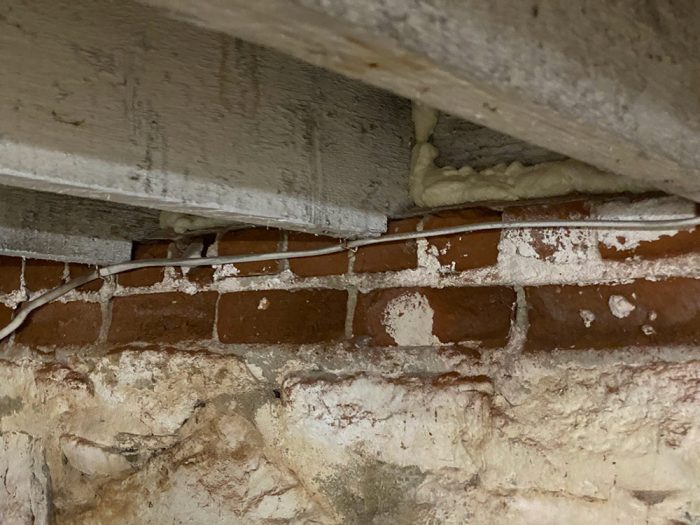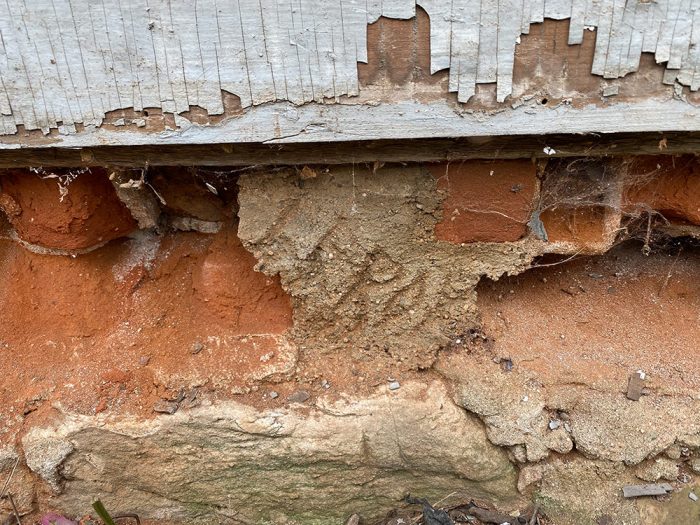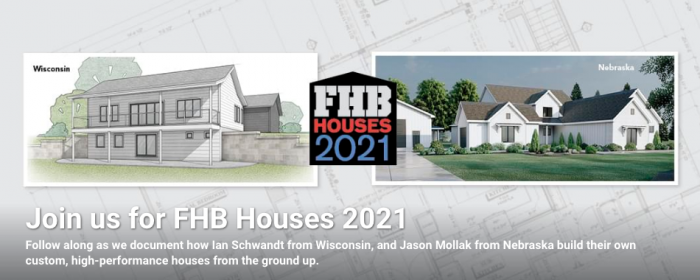Podcast 406: Changing to a Career in Construction, Building Your Own Addition, and Mixing Mortar for Stone
Rob, Kiley, and Patrick hear from listeners about electromagnetic radiation and trim over siding before taking listener questions about moving from a software company to construction, building your own addition, and homesteading in Canada.
Follow the Fine Homebuilding Podcast on your favorite app. Subscribe now and don’t miss an episode:
 |
 |
Help us make better episodes and enter for a chance to win an FHB Podcast T-shirt:
www.finehomebuilding.com/podcastsurvey
Rick offers a crash course in electromagnetic radiation. Mike Guertin has thoughts about exterior trim on top of siding. Dave tells us how to use Fibafuse drywall tape in inside corners. Chris asks how to break into residential construction. Abby wants to know how to get her new homestead started. James wonders if he should build his own addition. John asks about mortar mix for stone.
Editor Updates:
- Rob’s departure
- Kiley’s well
- Jeff’s deck railing
- Patrick’s day off
Related Links:
- Drive Well Point by Simmons Manufacturing
- Installing a Sand Point Well at the Off-Grid Cabin (video)
Listener Feedback 1:
Rick writes: Patrick, I’m in the Charlotte area. Always wanted to be a builder, but had a flair for physics in school and had a career in fiber optics for 20 years. The FHB podcast has bumped up against the physics of emissivity and electromagnetic radiation a few times, and it seems useful to explain a few concepts. Finer points will be glossed over, as we’re building houses, not designing satellites.
When we talk of heat moving around, radiation is often mentioned, but rarely detailed. That radiation is called electromagnetic radiation, and includes visible light, radio waves, microwaves, heat lamps, IR, UV, gamma rays, et cetera. It’s all fundamentally different frequencies of the same stuff and the keyword is ‘electromagnetic spectrum.’ When building scientists speak of longer or shorter wavelengths of radiation or light, this is what they’re referring to. The wavelength and frequency of EM radiation are inversely related. The wavelength of the EM Radiation in a vacuum multiplied by the frequency always equals the speed of light in a vacuum. I’ll stick to frequency here, but others will refer to wavelength. Tomato Tomahto.
Everything (pretty sure black holes count) emits a fairly broad EM radiation curve as a function of its temperature—hotter objects emit EM radiation curves with peaks at higher frequencies—this is how those non-contact thermometers work, as well as those thermal FLIR cameras. Most light bulb technologies follow these curves, and that’s where light bulb color temperatures come from. As an example, sunlight matches the curve for an object at 5778K, and tungsten filaments in light bulbs actually are running at 2700K. The shape of these curves are different across our eyes’ perception. See Planck’s Law for figures.
Emissivity is simply a measure of how much a material will emit EM radiation as a ratio to an ideal black body (which is beyond podcast depth), and varies from 0 to 1. Pick the materials with the most amount of emissivity, (over 0.9) and you can radiate away heat: super white paint, water, Brian, et cetera. Pick materials with the least emissivity (less than 0.1), and you can retain heat: mostly metals, and things that are polished. This is why IR thermometers don’t work well on metals or polished surfaces.
What was missed on the podcast discussion regarding Boilermaker White Paint is that objects emit EM radiation regardless of the temperature of the environment they’re in. They emit due to absolute temperature, full stop. An object in the vacuum of space or in a bowl of oatmeal will emit the same. So, if the material can emit well enough, but also reflect the incoming EM radiation, the material will cool. Simple enough, but not at all intuitive, because our daily experience is so tied to thermal conduction. Of course, a cool material attached to house framing will conduct heat out of the framing and into the material, so real world effect will be muted, but it will passively cool the house. So, where does the heat go? The atmosphere is nominally transparent, so most of the EM radiation goes out to space. Some narrow windows of that radiation can be absorbed by gas particles in the atmosphere, heating them. As those particles radiate their own EM radiation at other frequencies, figure half of the energy released will go back to heating the earth and the other half goes up to space. A few get intercepted along the way by other particles, but let’s not watch Inception again.
The emissivity of glass is 0.95ish, while the emissivity of metals is 0.04ish. Coat a window with a little metal, and you can move the emissivity to 0.2 or so. Now, the window will radiate away 1/5th the heat it would otherwise. Nice. Brand it as low-E, and hire a sales team. Also, for most objects, their emissivity is equal to their absorption: objects that emit heat well also tend to absorb it well. Making paint that reflects heat while still emitting heat is the Purdue accomplishment.
Radiant barriers simply reflect EM radiation, without asking for papers, regardless of which side LP wants to put it on, and regardless of which side the framers put up. 5700K Sunlight heats shingles, which radiate away their heat at 400K, and instead of the heat radiating to the rest of the house, it is reflected back into the shingles, which warms the shingles further, maybe to 422K. The warmer shingles dissipate heat to the atmosphere and radiate away their heat as EM radiation at a lower frequency. That radiant barrier continues to reflect the heat back at the shingles, and never gives up the fight.
The rabbit hole is well covered on Wikipedia and starts with the following terms: electromagnetic spectrum, electromagnetic radiation, emissivity, black body radiation, Planck’s Law.
Sidebar: Finding a formula to describe the exact type of electromagnetic radiation emitted by steel blast furnaces ovens at certain temperatures was a big industrial problem in the 1880s, and was not found until 1900. The theoretical explanation of the equation didn’t happen until 1924 and required a literal quantum leap to solve the problem, which was the impetus for the creation of quantum mechanics.
Keep your attic sealed, Rick
Related Links:
- Radiation: From Wikipedia
- Purdue University: The whitest paint is here – and it’s the coolest. Literally.
Listener Feedback 2:
Mike Guertin writes: Regarding the flashing question from Mike in Episode 400. I’m a nerd for flashing and siding so I couldn’t wait to get home and look at the photos you described of listener Mike’s house. The flashing installed over the head trim is sloppy (it is a little short of the end of the head trim and there’s not much of an outward slope). And it appears to be 0.011-in. thick metal rather than the IRC required 0.019 in. (this type of sub-par flashing is commonly stocked at building materials dealers unfortunately so it’s what most contractors default to). Otherwise, the flashing installation looks like will shed water perfectly fine because of the way the trim is applied over the top of the siding. I disagree with you and Mark that trim applied over the siding is incorrect. I looked closely at the photos and the products are LP SmartSide. The SmartSide instructions have alternate installation details showing trim applied over the top of the siding.
I realize it’s a shocking sight to see trim applied over siding but it’s a viable option. I believe it’s a more water-resistant detail than leaving the required 3/16-in. gap between lap siding and trim and caulking it. Narrow caulk joints are nearly impossible to execute properly, and they need periodic replacement. The paint coating on LP Smartside often lasts 15+ years before needing a recoat and that is often longer than the caulk seal lasts. Homeowners are rarely alerted to the fact that these caulk joints need periodic removal and replacement on a schedule that doesn’t match the long-durable paint finished available today. And I have yet to meet a painter who takes the time to carve out the old caulking before applying a bead of caulk. Usually painters just smodge a surface-applied coat of caulk over the old one. (You may recall the window flashing issue I brought up at the MWBSS a few weeks ago where water that enters the siding to window joint doesn’t get kicked out at the window sill level and ends up rotting the sheathing directly beneath the corners of the window. This happens even with caulked joints).
I began applying trim over all types of lap siding and shingles about 30 years ago on new homes and residing jobs including my own home and I wouldn’t do it any other way. I switched primarily to eliminate caulk joints and minimize maintenance. I feel I’m in good company too. Tim and Brian Uhler have been applying trim over siding for many years. They researched and experimented and feel it’s a better option even in their wet PNW climate. Brian posted a photo of window trim applied over cedar clapboard on a building built in the early 1900’s so we aren’t the first generation to go against the grain.
The two biggest complaints I hear from builders and siders about the trim-over-siding details is “That doesn’t look right” and “Bugs are going to nest in there”. To the first complaint, I point out that there are lots of details that were done traditionally in world of different materials and building assemblies that we now know we need to do differently—think current good practices of installing kickout flashings and leaving spaces of 1 in. to 2 in. between siding and the roof surface on roof-to-wall connections. To the second complaint, there are no more bugs nesting in those crannies than in any sheltered place like under the butt joints in siding or beneath soffits.
I’m always delighted when the podcast team offers conclusions to a construction situation that may not be accurate. It gives me and other listeners a chance to bring more information to the ongoing discussion of construction practices: what works, what doesn’t work, and situations like this where there are alternative methods that can perform just as well, and maybe even better.
Related Links:
Listener Feedback 3:
Dave writes: Hi, It was mentioned (not for the first time) in Episode 396 that Fibafuse drywall tape couldn’t be used for inside corners because the edge of the taping knife causes it to tear. However, I can confirm that inside corner tools, either professional-grade ones or even the clunky corner knives sold in big box stores, work fine for bedding the tape in corners without tearing. Shockingly, I learned this by reading the manufacturer’s installation instructions (download).
I first heard of Fibafuse tape when Justin Fink mentioned it on the FHB podcast several years ago, and it has helped me, as someone who finishes drywall only occasionally, achieve good results more quickly and easily, especially for patches and repairs-I’ll never use mesh tape again. Thanks so much for the podcast. I always find it entertaining and instructive, and I enjoy the personalities of all the regulars.
Related Links:
Question 1: Are there any websites that list construction jobs?
Chris writes: Hi All, I love listening to your podcast and reading the magazine back-to-back (I hate it when my wife scrolls ahead; no spoilers!). I’m currently in middle management in the manufacturing-software industry and would love to move back toward the construction industry as a career. Besides pursuing the “we’re hiring” pages of the companies advertised in the magazine, are there any sites or concentrated sites for listing general construction or construction-adjacent jobs?
Related Links:
Question 2: Where is the best place to start when it comes to building an off-grid, solar-powered forever home?
Abby writes: Hi team, I am an avid listener of the FHB podcast, and especially love the Keep Craft Alive content. My husband Greg and I have also enjoyed the magazine for many years. Thanks for all you do! We are getting ready to build our forever family homestead in our 100 acres of forested land in Ontario, Canada. The site is an elevated flat area on the north side of an east-west gently flowing river.
We are looking to build a home that is off-grid, mostly solar powered and we are hoping to use a lot of our own lumber to build the house. Our plan is to purchase a sawmill in the spring to cut and dry our red oak timbers. Red oak is not everyone’s top choice, but what we have in abundance here. We also have a lot of balsam fir, so possibly stick framing with that is another option?
We have done many sketches of our would-be house (a 3 bedroom, about 2700 square feet) but would really love to build this home with utmost consideration and care when it comes to a very well thought out design. So we need some professionals! Also, I myself am recently a cancer survivor and on the heels of that, it is very important to us to build a clean/healthy home that is high-performance, but also breathes naturally, and is built of good wholesome non-offgasing/toxic ingredients.
Though we both work, our intention is to make this home a working homestead, and to eventually add in a greenhouse, fruit orchard, vegetable gardens, and possibly some small livestock at some point. We will do much of the building work ourselves, and hire subcontractors locally that we already know, but we really want to get some good help with designing this house/site.
Building this home, on this particular land, is something deeply important and meaningful to us. We have already owned the property for 6 years and have been mindfully getting to know it, and are finally getting ready to build. And although I have an entire notebook full of sketches, the truth is I am not a designer or architect and we really want to get this place right. And though Greg is a builder, we both have realized that we know enough to know what we don’t know, so to speak. We are not experienced timber framers. Neither of us have direct experience building with passive principles. We are not experienced in setting up off-the grid solar etc. energy systems.
Basically, Greg is familiar with building big fancy summer homes for the local cottagers, but that market is not yet concerned with high performance, or natural materials or anything like that. (We would love to get some of that BS and Beer culture going on up here, because that movement doesn’t really exist here in our community yet).
So my question, after all of this, is… Where do we start?
Though we are capable of taking this project on without one, we are very open to hiring an architect that is familiar with building this kind of home. So, do we reach out to an architect first? Or first should we establish what type of wood we will be using and go from there? I don’t want to rule out straw-bale, earthen walls or any of those methods either, if it’s possible to have them in a high-performance house. I am open to all the ideas at this point, so don’t want to pigeon hole us into a certain design or approach.
Is there a person/architect that exists that would come to our site, see our available trees/materials and help us design a house based on what is available to us to work with? And if this person/company also has a passion for building natural/healthy homes (I don’t want to live inside a plastic bag), an appreciation for energy efficient/solar design, a history of designing a whole homestead and permaculture design layout (thinking access from house to garden, shop, barn etc..), that would b amazing. Do these people exist? What do they call themselves? I would love to find this unicorn who can establish an order of events for lining up the right team of advisors to help with this labour of love project? Thank you for making your way through this incredibly long story/question. Also, if you think this build sounds unique and worth writing about, please let me know- maybe we can share this adventure as it unfolds!
Related Links:
- Endeavour: The sustainable building school
- The Fine Homebuilding Interview: Chris Magwood
- An Introduction to Timber Framing
- Educational Opportunities are Key to Diversifying Builders
Question 3: Is it a bad idea to leave my office job to build a 600 sq. ft. addition myself?
James writes: Hi FHB podcast team! My wife and I are planning to build a 600 sq. ft addition to the back of our house next spring. We have a good contractor, who has done work for us before, who’s both available and interested in our project, but I am pulled by the appeal of leaving my office job for a time and trying to build most of it myself.
As a structural engineer with experience designing homes and renovations, I am familiar enough with the process of home construction, however my experience actually doing the work is limited to helping a friend frame a small addition and some projects like a pergola or the odd home repair. But I have found those limited projects to be immensely satisfying.
Does a project of this size seem like a crazy idea to take on? What do you think would be the biggest risks? One concern I have is that, especially in this very busy market, suppliers and subcontractors that I do not have an established relationship with, will either treat me as their lowest priority, or not even take my order. Lumber prices have come down but it is still hard to order engineered wood products in our area these days. Thanks for the thoughts!
Related Links:
Question 4: Which podcast episode talked about recommendations for mortar mix and lime for an old stone foundation?
John from Cincinnati, OH writes: I recall a podcast episode but can’t find it now when you discussed recommendations for the mortar mix and whether to use lime for repointing an old stone foundation. I recall somebody (wisely) suggesting to “consult with a local mason” since the mix might vary from region to region. I think there was some discussion of the pros and cons of using lime. I think there were some other pearls of wisdom in that episode, so I was hoping to go back and re-listen. I live in an ~1880s home in Cincinnati with a stone foundation that needs repair (the mortar is crumbling off and there is efflorescence from hydrostatic pressure). Can you point me to that episode and/or discuss on an upcoming podcast? Thanks!
Related Links:
- Limeworks: Free Observation Of Your Sample
- Limeworks: FAQs
- Lancaster Limeworks: Basics of Mortar Sand
- Lancaster Limeworks: Basics of Binders in Mortar
- Repointing Mortar Joints in Historic Masonry Buildings
- Podcast 388: Delayed Windows, Whitewashing Brick, and Cooling Off Upstairs
Check out our latest Project Guide: Siding & Exterior Trim!
Check out our new 2021 FHB Houses:
Visit the Taunton Store • Magazine Index • Online Archive • Our First Issues • All Access
Help us make better episodes and enter for a chance to win an FHB Podcast T-shirt: www.finehomebuilding.com/podcastsurvey

If you have any questions you would like us to dig into for a future show, shoot an email our way: [email protected].
If we use your question we’ll send you a FHB Podcast sticker!
FHB Podcast T-shirts!
Represent your favorite podcast! Available in several styles and colors. Made from 100% cotton. Find the Podcast t-shirt and more cool products in the Fine Homebuilding Store.
Fine Homebuilding podcast listeners can now get 20% off anything in the Taunton store, including Insulate & Weatherize.
Use the discount code FHBPODCAST to take advantage of this special offer.
We hope you will take advantage of a great offer for our podcast listeners: A special 20% off the discounted rate to subscribe to the Fine Homebuilding print magazine. That link goes to finehomebuilding.com/podoffer.
The show is driven by our listeners, so please subscribe and rate us on iTunes or Google Play, and if you have any questions you would like us to dig into for a future show, shoot an email our way: [email protected]. Also, be sure to follow Fine Homebuilding on Instagram, and “like” us on Facebook. Note that you can watch the show above, or on YouTube at the Fine Homebuilding YouTube Channel.
The Fine Homebuilding Podcast embodies Fine Homebuilding magazine’s commitment to the preservation of craftsmanship and the advancement of home performance in residential construction. The show is an informal but vigorous conversation about the techniques and principles that allow listeners to master their design and building challenges.
Other related links
-
- All FHB podcast show notes: FineHomebuilding.com/podcast.
- #KeepCraftAlive T-shirts and hats support scholarships for building trades students. So order some gear at KeepCraftAlive.org.
- The direct link to the online store is here.
